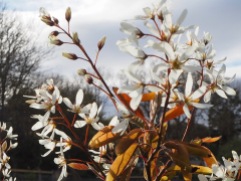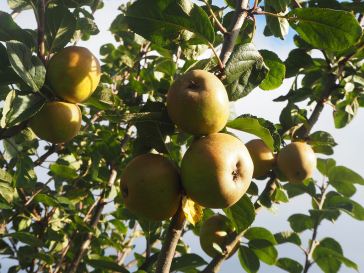As 2020 limps to a close, I feel privileged to be able to look back over a year in the garden. Gardens and gardening have always been important to me but this year the patch of land that is our developing garden has felt doubly precious.
Early in the year, as the pandemic took hold, the budding and blooming of early spring flowers gave familiarity in the midst of uncertainty. Our young almond tree flowered under a clear, blue sky in March, lending an improbable hint of the Mediterranean to the sunniest corner of the garden. In early April the amelanchiers opened their delicate white blossom while the apple buds swelled slowly, waiting for warmer days.
By Easter the subtle colours of the early spring flowers had been joined by bright wallflowers and daffodils. Unable to invite friends into the garden, I filled our front window with vases of flowers, to share with passersby through the glass. The next weekend, inspired by stories of people finding creative ways to reach out to their neighbours during lockdown, I picked an armful of flowers from the garden, tied them in bunches and put them in a bucket outside our gate with a ‘help yourself’ sign. I didn’t see anyone passing by but half an hour later the first bunch disappeared. A few hours later the bucket was empty.
I’d already planned to grow a lot of cut flowers this year, trying out different varieties before possibly expanding to growing for local sale. Clearly there were people around who were glad to be offered a bunch of flowers for free. The middle of a national lockdown didn’t feel like the right time to start offering flowers for sale so the next Saturday two ‘help-yourself’ buckets were by the gate. By May, when restrictions eased, the garden was coming into full bloom and the Saturday flower buckets had become an enjoyable part of my weekly routine. It was only in October, when the supply of flowers started to run out, that I decided it was time to call a halt.
I learnt a lot over the season, about the characteristics of each species and the practicalities of growing flowers for cutting. My cutting patch easily produced enough flowers for ten mixed bunches each week. Cutting, conditioning and tying ten bunches of flowers was a pleasure but scaling up to even the smallest scale commercial production would take a lot of work!
Alchemilla and nepeta provided invaluable ‘filler’ for mixed posies, supporting the larger flowers and setting them off to advantage. Both thrive on regular cutting, sending out new shoots to keep flowering for months on end. Strong-growing annual calendulas looked wonderful in the garden but turned out to be disappointingly short-lived as cut flowers. By contrast annual cornflowers looked delicate but proved robust. The flowers last over a week in water and, provided you keep cutting, the plants keep flowering well into the autumn. Sylvia was the star of the dahlia patch, producing dozens of large, richly coloured heads on long, strong stalks from August till October. Curiously the same plants produced flowers that were a rich orange in summer but a soft, butter yellow in autumn.
The garden doesn’t only produce flowers. The orchard is my personal project but the veg plot is my spouse’s preserve, where he can garden in peace without me interfering. It was a good year for potatoes, for peas and beans, cabbages and kale. We didn’t keep up with the beetroot, which grew enormous, or with the courgettes that turned into marrows. The first apples were ripe in September, the last not ready for picking until November. That late crop, of Ashmead’s Kernel, will keep us in fruit for another month or two yet.
There’s something important missing from my photos of the year in the garden – the people we were able to share it with. From June to October, when Covid precautions allowed, the sheltered back yard was the heart of our home. Coffee or lunch in the garden with friends is a pleasure and a privilege I won’t take for granted in future.
As the year ends we’re back to hellebores again, a reminder that though the worst of the winter may be still to come, spring isn’t far away.





















December 31, 2020 at 6:41 pm
What a lovely account of your year, and the way you have settled into your now not-so-new community. You’ve been productive : I’ll be interested to hear if you decide to pursue the cut flower business option. All good wishes for 2021.
LikeLiked by 1 person
December 31, 2020 at 7:00 pm
Thank you, Margaret. I’ll keep growing cut flowers and see what next year brings. Happy New Year!
LikeLiked by 1 person
January 1, 2021 at 5:02 pm
This is my favorite post to date on your site! Beautiful and almost poetic!
LikeLiked by 1 person
January 1, 2021 at 5:35 pm
Thank you for your encouragement, Carolee.
LikeLike
January 2, 2021 at 1:40 am
A beautiful review of the amazing things you have achieved in your garden since moving to Berwick. Truly inspiring.
LikeLiked by 2 people
January 2, 2021 at 10:06 am
Thanks, Stephen. We’ve had a lot of time to devote to the garden and few distractions the year! Even so, I should maybe have mentioned some more of the failures…
LikeLiked by 2 people
January 3, 2021 at 2:03 am
More than content with the successes.
LikeLiked by 2 people
March 2, 2021 at 10:01 am
A good heart! ❤ I wish you a wonderful incoming spring.
LikeLiked by 2 people
March 2, 2021 at 3:44 pm
Many thanks, Manja. I’m glad you’ve enjoyed your catch-up with Beyond the Window Box!
LikeLiked by 2 people